Interplay of Regional Climate Change and Urban Effects: Projected Impacts on Tourism Climate Potential in Szeged, Hungary
Abstract
1. Introduction
- Whether the applied surface model can detect urban-induced alterations in tourism climate indices;
- How potential urban impacts are displayed in the spatial and temporal patterns of these indices;
- Assessing projected future changes in tourism climate conditions due to the combined effects of regional climate change and urban climate processes, across different time periods and emission scenarios;
- Identifying the implications of potential future redistribution of tourism potential for the study area.
2. Materials and Methods
2.1. Study Area
2.2. Applied Tourism Climate Indices
2.3. SURFEX Model and Configuration
2.4. Data Processing
- A multi-step bias-correction procedure was applied to the basic data from the ALADIN regional climate model and fine-scale SURFEX model, prepared by HungaroMet;
- Using the bias-corrected data, daily values of the two tourism climate indices were calculated for both the reference period and future periods under different emission scenarios;
- For each case, the spatial distributions of the indices were presented in monthly maps.
3. Results
3.1. Urban Alterations of Tourism Climate Indices
3.2. Projected Future Trends in Tourism Climate Conditions
4. Discussion
5. Conclusions
- Using a high-resolution, multi-model approach, the modification of tourism’s climate potential by urban surfaces is clearly evident in the medium-sized Central European settlement under investigation. The results suggest that even in a city the size of Szeged, based on 30-year climatic averages, diverse spatial and temporal characteristics can emerge. This underscores the need for more in-depth analyses of tourism climate conditions in cities with similar climatic, urban density, and socio-cultural characteristics than is currently undertaken.
- Through the influence of the climate parameters that constitute the indices, the greatest changes occur in the densely built-up surface categories (i.e., industrial and commercial, dense urban, and temperate sub-urban areas), regardless of the time period examined. In cities with structures similar to Szeged, tourism activities are predominantly concentrated in downtown areas (e.g., museums, theatres, churches, and leisure centres). Therefore, climate change mitigation efforts should primarily target these areas. However, only spatially differentiated interventions, combined with continuous monitoring of their effects, can produce meaningful improvements.
- Due to their design, the indices used do not uniformly capture the temporal influence of the city on tourism’s climate potential. Climatic conditions are generally more favourable in the city during May and September compared to surrounding rural areas. However, during the summer period, typically the peak of the tourism season in Central Europe, the two indices may lead to differing conclusions. Regardless of which index more accurately reflects reality, establishing sustainable tourism in Szeged and its region requires enhancing the adaptive capacity of areas most affected by climate change. This may involve strengthening existing positive measures (e.g., increasing artificial shading) or implementing new interventions (e.g., integrating green and blue infrastructure). While cities in the region exhibit unique urban climate conditions due to varying characteristics and functions, transferring best practices that align with local environmental and tourism contexts can yield effective strategic outcomes.
- Regional climate projections indicate a clear warming trend for Szeged. From a tourism perspective, this is expected to further intensify the existing bimodal annual distribution of climatic conditions, potentially enhancing tourism activity during most transitional months while reducing it during the traditional peak season (May to September) in cities with similar climates. Overall, this could lead to an extended tourism season and increased activity in spring and autumn. Consequently, in practical terms, urban planners and stakeholders should aim to improve comfort levels in urban areas during summer months (as highlighted above) and extend the viable tourism season. This would help maintain tourism volumes and associated revenues at levels comparable to current figures.
Supplementary Materials
Author Contributions
Funding
Data Availability Statement
Acknowledgments
Conflicts of Interest
Abbreviations
| DKMT | Danube–Criș–Mureș–Tisa Euroregion |
| HCI | Holiday Climate Index |
| mTCI | modified Tourism Climate Index |
| TCI | Tourism Climate Index |
| PET | Physiologically Equivalent Temperature |
| SURFEX | Surface Externalisée |
| TEB | Town Energy Balance |
| ISBA | Interactions between Soil–Biosphere–Atmosphere |
| RCP | Representative Concentration Pathways |
| NNS | Nearest neighbour search |
| WRF | Weather Research and Forecasting |
| LCZ | Local Climate Zones |
| SSP | Shared Socioeconomic Pathways |
Appendix A

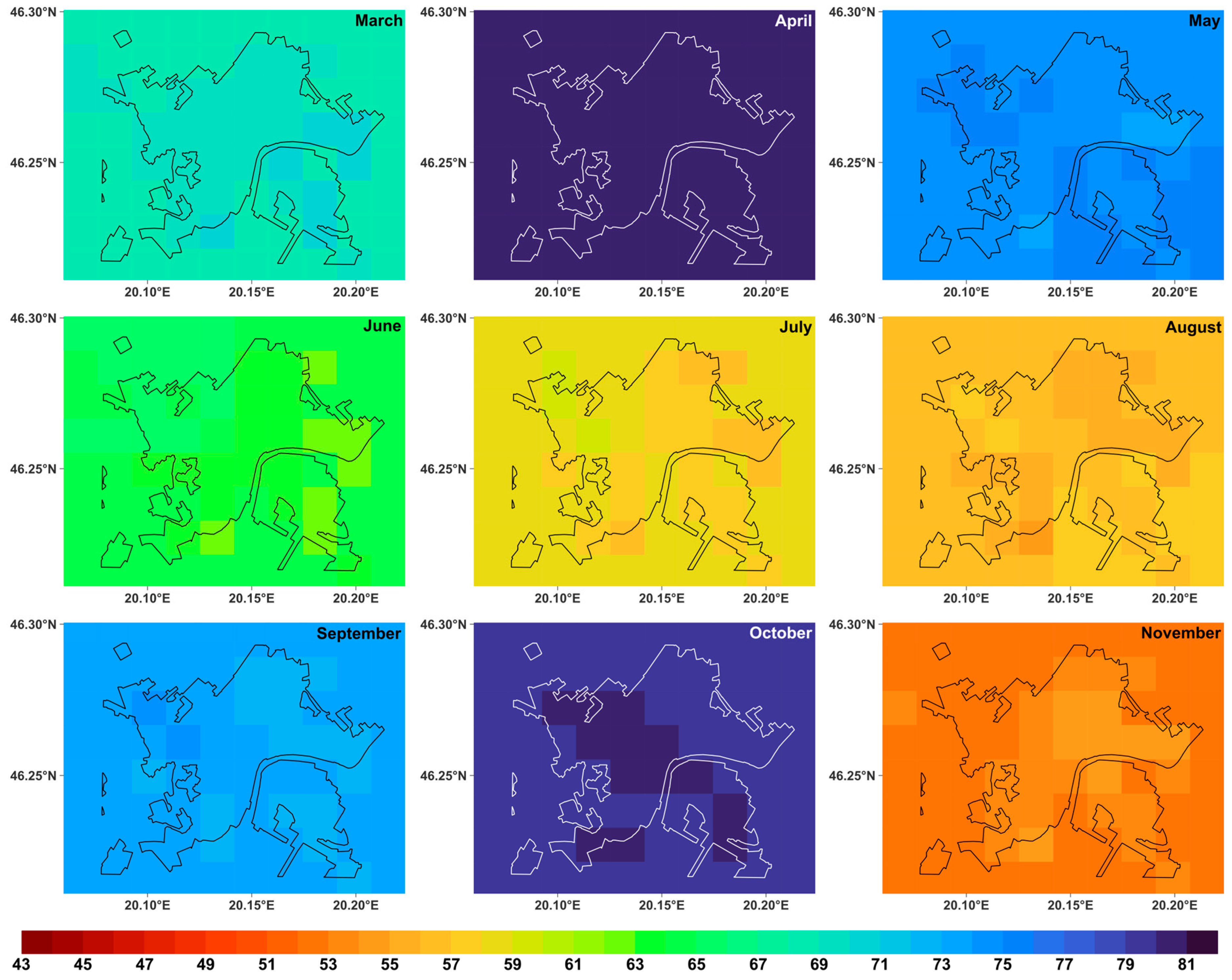
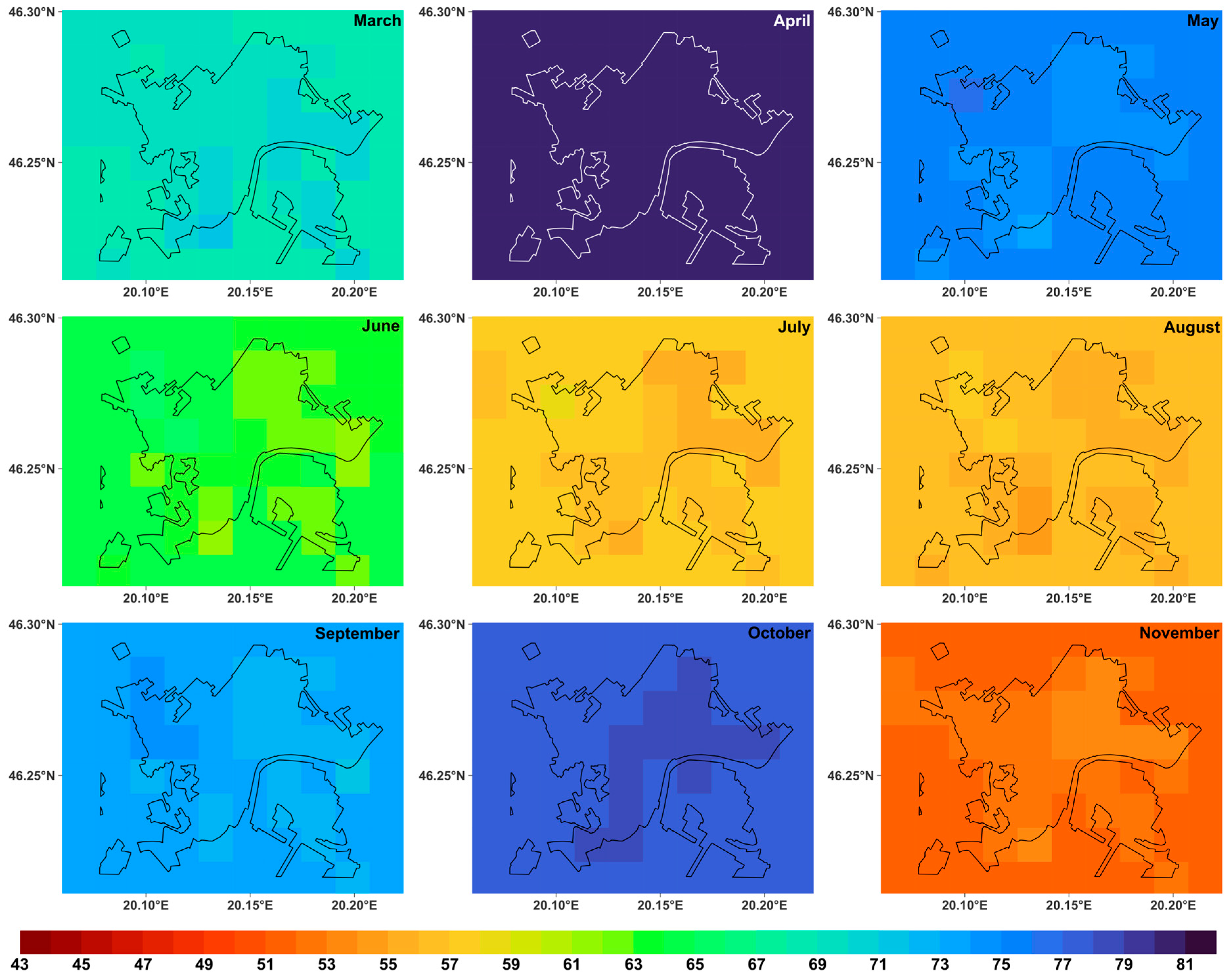
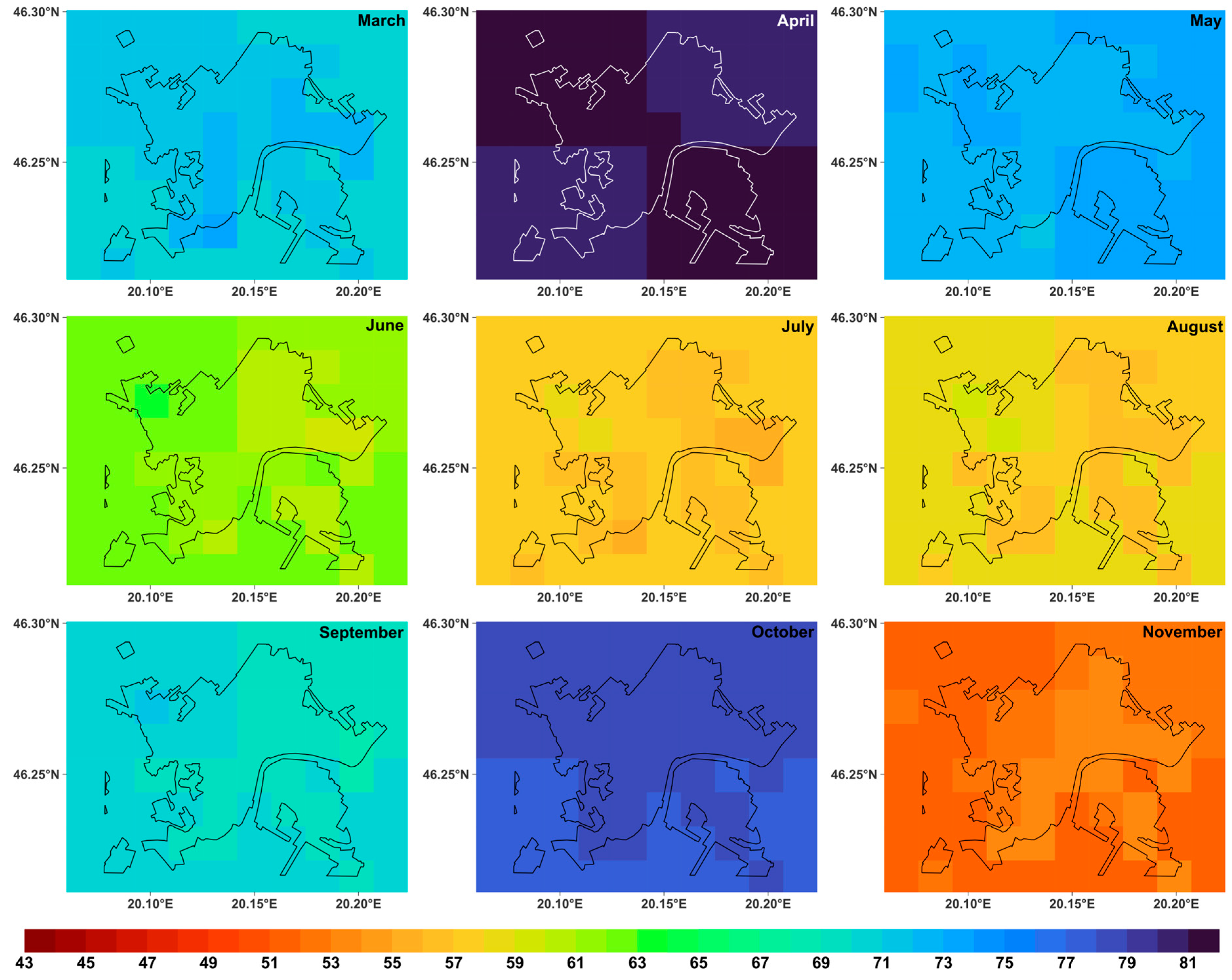

References
- UNWTO. World Tourism Barometer; World Tourism Organization: Madrid, Spain, 2025; Volume 23. [Google Scholar] [CrossRef]
- WTTC. Press Release: Travel & Tourism to Create 4.5MN New Jobs Across the EU by 2035; World Travel & Tourism Council: London, UK, 2025; Available online: https://wttc.org/news/travel-and-tourism-to-create-4-5mn-new-jobs-across-the-eu-by-2035 (accessed on 4 June 2025).
- HCSO. Tourism Satellite Accounts, 2023; Hungarian Central Statistical Office: Budapest, Hungary, 2024; Available online: https://www.ksh.hu/s/en/publications/tourism-satellite-accounts-2023 (accessed on 4 June 2025).
- HCSO. The Number of Inbound Trips to Hungary and the Related Expenditures by Main Motivation; Hungarian Central Statistical Office: Budapest, Hungary, 2025; Available online: https://www.ksh.hu/stadat_files/tur/en/tur0005.html (accessed on 4 June 2025).
- UNWTO. Global Report on City Tourism—Cities 2012 Project; World Tourism Organization: Madrid, Spain, 2012; Available online: https://www.e-unwto.org/doi/epdf/10.18111/9789284415300 (accessed on 4 June 2025).
- Castela, A. Impacts of tourism in an urban community: The case of Alfama. Athens J. Tour. 2018, 5, 133–148. [Google Scholar] [CrossRef]
- UNWTO. Expert Group Meeting, Final Report; Advancing Sustainable Urban Tourism: Tools for Promoting Good Practices in Cities and Territories; World Tourism Organization: Bilbao, Spain, 2024; Available online: https://observatorio2030.com/sites/default/files/2024-11/Advancing%20sustainable%20urban%20tourism.pdf (accessed on 4 June 2025).
- Mieczkowski, Z.T. The tourism climatic index: A method of evaluating world climates for tourism. Can. Geogr. 1985, 29, 220–233. [Google Scholar] [CrossRef]
- Smith, K. The influence of weather and climate on recreation and tourism. Weather 1993, 48, 398–404. [Google Scholar] [CrossRef]
- de Freitas, C.R. Tourism climatology: Evaluating environmental information for decision making and business planning in the recreation and tourism sector. Int. J. Biometeorol. 2003, 48, 45–54. [Google Scholar] [CrossRef] [PubMed]
- Gómez Martín, M.B. Weather, climate and tourism. A geographical perspective. Ann. Tour. Res. 2005, 32, 571–591. [Google Scholar] [CrossRef]
- Lohmann, M.; Kaim, E. Weather and holiday destination preferences image, attitude and experience. Tour. Rev. 1999, 54, 54–64. [Google Scholar] [CrossRef]
- Gössling, S.; Bredberg, M.; Randow, A.; Sandström, E.; Svensson, P. Tourist perceptions of climate change: A study of international tourists in Zanzibar. Curr. Issues Tour. 2006, 9, 419–435. [Google Scholar] [CrossRef]
- Scott, D.; McBoyle, G.; Schwartzentruber, M. Climate change and the distribution of climatic resources for tourism in North America. Clim. Res. 2004, 27, 105–117. [Google Scholar] [CrossRef]
- Hein, L.; Metzger, M.J.; Moreno, A. Potential impacts of climate change on tourism; a case study for Spain. Curr. Opin. Environ. Sustain. 2009, 1, 170–178. [Google Scholar] [CrossRef]
- Perch-Nielsen, S.L.; Amelung, B.; Knutti, R. Future climate resources for tourism in Europe based on the daily Tourism Climatic Index. Clim. Change 2010, 103, 363–381. [Google Scholar] [CrossRef]
- Amelung, B.; Moreno, A. Costing the impact of climate change on tourism in Europe: Results of the PESETA project. Clim. Change 2012, 112, 83–100. [Google Scholar] [CrossRef]
- Barrutiabengoa, J.M.; Carta, G.; González, N.; Pérez, D.; Más, P.; Yücel, G. Climate change scenarios and the evolution of Spanish tourism. Clim. Change 2025, 178, 129. [Google Scholar] [CrossRef]
- Maddison, D. In search of warmer climates? The impact of climate change on flows of British tourists. Clim. Change 2001, 49, 193–208. [Google Scholar] [CrossRef]
- Lise, W.; Tol, R.S.J. Impact of climate on tourist demand. Clim. Change 2002, 55, 429–449. [Google Scholar] [CrossRef]
- Agnew, M.D.; Palutikof, J.P. Impacts of short-term climate variability in the UK on demand for domestic and international tourism. Clim. Res. 2006, 31, 109–120. [Google Scholar] [CrossRef]
- Eugenio-Martin, J.L.; Campos-Soria, J.A. Climate in the region of origin and destination choice in outbound tourism demand. Tour. Manag. 2010, 31, 744–753. [Google Scholar] [CrossRef]
- Aygün Oğur, A.; Baycan, T. Assessing climate change impacts on tourism demand in Turkey. Environ. Dev. Sustain. 2023, 25, 2905–2935. [Google Scholar] [CrossRef]
- Lemesios, I.; Varotsos, K.V.; Georgopoulou, E.; Sarafidis, Y.; Kapetanakis, D.; Mirasgedis, S.; Gakis, N.; Giannakopoulos, C. Effects of climate change on the future attractiveness of tourist destinations in Greece. Atmosphere 2024, 15, 1185. [Google Scholar] [CrossRef]
- Çalişkan, O.; Çiçek, I.; Matzarakis, A. The climate and bioclimate of Bursa (Turkey) from the perspective of tourism. Theor. Appl. Climatol. 2012, 107, 417–425. [Google Scholar] [CrossRef]
- Ndetto, E.L.; Matzarakis, A. Basic analysis of climate and urban bioclimate of Dar es Salaam, Tanzania. Theor. Appl. Climatol. 2013, 114, 213–226. [Google Scholar] [CrossRef]
- Salata, F.; Golasi, I.; Proietti, R.; de Lieto Vollaro, A. Implications of climate and outdoor thermal comfort on tourism: The case of Italy. Int. J. Biometeorol. 2017, 61, 2229–2244. [Google Scholar] [CrossRef]
- Mansuroğlu, S.; Dağ, V.; Önaç, A.K. Attitudes of people toward climate change regarding the bioclimatic comfort level in tourism cities; evidence from Antalya, Turkey. Environ. Monit. Assess. 2021, 193, 420. [Google Scholar] [CrossRef]
- Caldeira, A.M.; Kastenholz, E. It’s so hot: Predicting climate change effects on urban tourists’ time–space experience. J. Sustain. Tour. 2018, 26, 1516–1542. [Google Scholar] [CrossRef]
- Holec, J.; Feranec, J.; Šťastný, P.; Szatmári, D.; Kopecká, M.; Garaj, M. Evolution and assessment of urban heat island between the years 1998 and 2016: Case study of the cities Bratislava and Trnava in western Slovakia. Theor. Appl. Climatol. 2020, 141, 979–997. [Google Scholar] [CrossRef]
- Molnár, G.; Kovács, A.; Gál, T. How does anthropogenic heating affect the thermal environment in a medium-sized Central European city? A case study in Szeged, Hungary. Urban Clim. 2020, 34, 100673. [Google Scholar] [CrossRef]
- Arnfield, A.J. Two decades of urban climate research: A review of turbulence, exchanges of energy and water, and the urban heat island. Int. J. Climatol. 2003, 23, 1–26. [Google Scholar] [CrossRef]
- Molnár, G.; Gyöngyösi, A.Z.; Gál, T. Integration of an LCZ-based classification into WRF to assess the intra-urban temperature pattern under a heatwave period in Szeged, Hungary. Theor. Appl. Climatol. 2019, 138, 1139–1158. [Google Scholar] [CrossRef]
- Zsebeházi, G.; Mahó, S.I. Assessment of the urban impact on surface and screen-level temperature in the ALADIN-Climate driven SURFEX land surface model for Budapest. Atmosphere 2021, 12, 709. [Google Scholar] [CrossRef]
- Megyeri-Korotaj, O.A.; Bán, B.; Suga, R.; Allaga-Zsebeházi, G.; Szépszó, G. Assessment of climate indices over the Carpathian Basin based on ALADIN5.2 and REMO2015 regional climate model simulations. Atmosphere 2023, 14, 448. [Google Scholar] [CrossRef]
- Allaga-Zsebeházi, G. Estimating the Climate Change Impacts in Urban Areas Using the SURFEX Land Surface Model. Ph.D. Dissertation, Eötvös Loránd University, Budapest, Hungary, 2024. [Google Scholar] [CrossRef]
- Žgela, M.; Herceg-Bulić, I.; Lozuk, J.; Jureša, P. Linking land surface temperature and local climate zones in nine Croatian cities. Urban Clim. 2024, 54, 101842. [Google Scholar] [CrossRef]
- Tasan, M.; Dąbrowska, J.; Michałowska, K. Surface urban heat islands during heatwaves: Thermal impacts on the built environment in selected polish cities. Build. Environ. 2025, 285 Pt B, 113603. [Google Scholar] [CrossRef]
- HMS. Climate Data Series 1901–2020, Szeged; HungaroMet Hungarian Meteorological Service: Budapest, Hungary, 2021; Available online: https://met.hu/en/eghajlat/magyarorszag_eghajlata/eghajlati_adatsorok/Szeged/adatok/eves_adatok (accessed on 18 June 2025).
- HCSO. Tourist Arrivals and Tourism Nights at Tourist Accommodation Establishments in Budapest and by Tourism Areas; Hungarian Central Statistical Office: Budapest, Hungary, 2025; Available online: https://www.ksh.hu/stadat_files/tur/en/tur0086.html (accessed on 20 June 2025).
- HCSO. Tourism Nights at Tourist Accommodation Establishments in Budapest and by Tourism Areas (Monthly Data); Hungarian Central Statistical Office: Budapest, Hungary, 2025; Available online: https://www.ksh.hu/stadat_files/tur/en/tur0081.html (accessed on 20 June 2025).
- Scott, D.; Rutty, M.; Amelung, B.; Tang, M. An inter-comparison of the Holiday Climate Index (HCI) and the Tourism Climate Index (TCI) in Europe. Atmosphere 2016, 7, 80. [Google Scholar] [CrossRef]
- Kovács, A.; Unger, J.; Gál, C.V.; Kántor, N. Adjustment of the thermal component of two tourism climatological assessment tools using thermal perception and preference surveys from Hungary. Theor. Appl. Climatol. 2016, 125, 113–130. [Google Scholar] [CrossRef]
- Kovács, A.; Németh, Á.; Unger, J.; Kántor, N. Tourism climatic conditions of Hungary—Present situation and assessment of future changes. Időjárás (Q. J. Hung. Meteorol. Serv.) 2017, 121, 79–99. [Google Scholar]
- Kovács, A.; Molnár, G.; Megyeri-Korotaj, O.A. Projected climate suitability for Hungarian tourism in the 21st century: Application of the Holiday Climate Index and modified Tourism Climate Index. Int. J. Biometeorol. 2025, 69, 1429–1442. [Google Scholar] [CrossRef] [PubMed]
- Höppe, P. The physiological equivalent temperature—A universal index for the biometeorological assessment of the thermal environment. Int. J. Biometeorol. 1999, 43, 71–75. [Google Scholar] [CrossRef]
- Burke, M.; Sipe, N.; Evans, R.; Mellifont, D. Climate, geography and the propensity to walk: Environmental factors and walking trip rates in Brisbane. In Proceedings of the 29th Australasian Transport Research Forum, Gold Coast, Australia, 27–29 September 2006. [Google Scholar]
- Kántor, N.; Kovács, A.; Takács, Á. Seasonal differences in the subjective assessment of outdoor thermal conditions and the impact of analysis techniques on the obtained results. Int. J. Biometeorol. 2016, 60, 1615–1635. [Google Scholar] [CrossRef] [PubMed]
- Kovács, A.; Király, A. Assessment of climate change exposure of tourism in Hungary using observations and regional climate model data. Hung. Geogr. Bull. 2021, 70, 215–231. [Google Scholar] [CrossRef]
- Rutty, M.; Scott, D.; Matthews, L.; Burrowes, R.; Trotman, A.; Mahon, R.; Charles, A. An inter-comparison of the Holiday Climate Index (HCI:Beach) and the Tourism Climate Index (TCI) to explain Canadian tourism arrivals to the Caribbean. Atmosphere 2020, 11, 412. [Google Scholar] [CrossRef]
- Masson, V.; Le Moigne, P.; Martin, E.; Faroux, S.; Alias, A.; Alkama, R.; Belamari, S.; Barbu, A.; Boone, A.; Bouyssel, F.; et al. The SURFEXv7.2 land and ocean surface platform for coupled or offline simulation of earth surface variables and fluxes. Geosci. Model Dev. 2013, 6, 929–960. [Google Scholar] [CrossRef]
- KlimAdat Project, Implemented in the Framework of the Environmental and Energy Efficiency Operative Program (KEHOP-1.1.0). Available online: https://www.met.hu/klimadat/en/kezdo (accessed on 2 October 2024).
- Zsebeházi, G. Az ALADIN-Climate-tal Meghajtott SURFEX Modellkísérletek Eredményeinek Validációja (Validation of the ALADIN-Climate Driven SURFEX Simulations’ Results); Project Report, KlimAdat (KEHOP-1.1.0) Project; Hungarian Meteorological Service: Budapest, Hungary, 2020; Available online: https://www.met.hu/downloads.php?fn=/klimadat/doc/reports/KLIMADAT_beszamolo_Zsebehazi_202010.pdf (accessed on 2 October 2024).
- Zsebeházi, G.; Szépszó, G. Modeling the urban climate of Budapest using the SURFEX land surface model driven by the ALADIN-Climate regional climate model results. Időjárás (Q. J. Hung. Meteorol. Serv.) 2020, 124, 191–207. [Google Scholar] [CrossRef]
- Allaga-Zsebeházi, G. Future temperature and urban heat island changes in Budapest: A comparative study based on the HMS-ALADIN and SURFEX models. Időjárás (Q. J. Hung. Meteorol. Serv.) 2021, 125, 675–692. [Google Scholar] [CrossRef]
- Allaga-Zsebeházi, G. Az RCP4.5 és RCP8.5 Forgatókönyvekkel Készített SURFEX Városi Éghajlatváltozási Kísérletek Kiértékelése (Evaluation of the SURFEX Urban Climate Projections Using the RCP4.5 and RCP8.5 Anthropogenic Scenarios); Project Report, KlimAdat (KEHOP-1.1.0) Project; Hungarian Meteorological Service: Budapest, Hungary, 2021; Available online: https://www.met.hu/downloads.php?fn=/klimadat/doc/reports/KLIMADAT_beszamolo_Allaga-Zsebehazi_202112.pdf (accessed on 2 October 2024).
- Masson, V. A physically-based scheme for the urban energy budget in atmospheric models. Bound Layer. Meteorol. 2000, 94, 357–397. [Google Scholar] [CrossRef]
- Noilhan, J.; Mahfouf, J.-F. The ISBA land surface parameterisation scheme. Glob. Planet. Change 1996, 13, 145–159. [Google Scholar] [CrossRef]
- Masson, V.; Champeaux, J.-L.; Chauvin, F.; Meriguet, C.; Lacaze, R. A global database of land surface parameters at 1-km resolution in meteorological and climate models. J. Clim. 2003, 16, 1261–1282. [Google Scholar] [CrossRef]
- Bán, B.; Megyeri, O.A.; Suga, R. Az ALADIN5.2 és a REMO2015 Regionális Klímamodellek Múltbeli Időszakra Vonatkozó Eredményeinek Validációja (Validation of the ALADIN5.2 and REMO2015 Regional Climate Models’ Results for a Past Period); Project Report, KlimAdat (KEHOP-1.1.0) Project; Hungarian Meteorological Service: Budapest, Hungary, 2021; Available online: https://www.met.hu/downloads.php?fn=/klimadat/doc/reports/KLIMADAT_beszamolo_ALADIN_REMO_final.pdf (accessed on 2 October 2024).
- Bán, B.; Szépszó, G.; Allaga-Zsebeházi, G.; Somot, S. ALADIN-Climate at the Hungarian Meteorological Service: From the beginnings to the present day’s results. Időjárás (Q. J. Hung. Meteorol. Serv.) 2021, 125, 647–673. [Google Scholar] [CrossRef]
- Voldoire, A.; Sanchez-Gomez, E.; Salas y Mélia, D.; Decharme, B.; Cassou, C.; Sénési, S.; Valcke, S.; Beau, I.; Alias, A.; Chevallier, M.; et al. The CNRM-CM5.1 global climate model: Description and basic evaluation. Clim. Dyn. 2013, 40, 2091–2121. [Google Scholar] [CrossRef]
- van Vuuren, D.P.; Edmonds, J.; Kainuma, M.; Riahi, K.; Thomson, A.; Hibbard, K.; Hurtt, G.C.; Kram, T.; Krey, V.; Lamarque, J.-F.; et al. The representative concentration pathways: An overview. Clim. Change 2011, 109, 5–31. [Google Scholar] [CrossRef]
- Matzarakis, A.; Rutz, F.; Mayer, H. Modelling radiation fluxes in simple and complex environments: Basics of the RayMan model. Int. J. Biometeorol. 2010, 54, 131–139. [Google Scholar] [CrossRef]
- Bihari, Z.; Lakatos, M.; Szentimrey, T. Felszíni megfigyelésekből készített rácsponti adatbázisok az Országos Meteorológiai Szolgálatnál (Gridded data series prepared from surface observation at Hungarian Meteorological Service). Légkör 2017, 62, 148–151. [Google Scholar]
- SURFEX User’s Guide V8.1, 2020. Available online: https://www.umr-cnrm.fr/surfex/IMG/pdf/surf-v8-1d.pdf (accessed on 11 December 2024).
- Hawkins, E.; Osborne, T.M.; Ho, C.K.; Challinor, A.J. Calibration and bias correction of climate projections for crop modelling: An idealised case study over Europe. Agric. Meteorol. 2013, 170, 19–31. [Google Scholar] [CrossRef]
- Szépszó, G. A REMO Regionális Éghajlati Modellen Alapuló Klímadinamikai Vizsgálatok a KÁRPÁT-Medence Éghajlatának Jellemzésére (Climate Dynamics Investigations for the Carpathian Basin with the REMO Regional Climate Model). Ph.D. Dissertation, Eötvös Loránd University, Budapest, Hungary, 2014. [Google Scholar]
- Scott, D.; McBoyle, G. Using a ‘tourism climate index’ to examine the implications of climate change for climate as a tourism resource. In Proceedings of the First International Workshop on Climate, Tourism and Recreation, Porto Carras, Neos Marmaras, Halkidiki, Greece, 5–10 October 2001; pp. 69–88. [Google Scholar]
- Qi, L.; Hu, Y.; Bu, R.; Li, B.; Gao, Y.; Li, C. Evaluation of the thermal environment based on the urban neighborhood heat/cool island effect. Land 2024, 13, 933. [Google Scholar] [CrossRef]
- Wen, J.; Chen, J.; Lin, W.; Jiang, B.; Xu, S.; Lan, J. Impacts of anthropogenic heat flux and urban land-use change on frontal rainfall near coastal regions: A case study of a rainstorm over the Pearl River Delta, South China. J. Appl. Meteorol. Climatol. 2020, 59, 363–379. [Google Scholar] [CrossRef]
- Gunawardena, K.R.; Wells, M.J.; Kershaw, T. Utilising green and bluespace to mitigate urban heat island intensity. Sci. Total Environ. 2017, 584–585, 1040–1055. [Google Scholar] [CrossRef] [PubMed]
- Kastner-Klein, P.; Fedorovich, E.; Rotach, M.W. A wind tunnel study of organised and turbulent air motions in urban street canyons. J. Wind Eng. Ind. Aerodyn. 2001, 89, 849–861. [Google Scholar] [CrossRef]
- Wang, J.; Feng, J.; Yan, Z. Potential sensitivity of warm season precipitation to urbanization extents: Modeling study in Beijing-Tianjin-Hebei urban agglomeration in China. J. Geophys. Res. Atmos. 2015, 120, 9408–9425. [Google Scholar] [CrossRef]
- Carrillo, J.; González, A.; Pérez, J.C.; Expósito, F.J.; Díaz, J.P. Projected impacts of climate change on tourism in the Canary Islands. Reg. Environ. Change 2022, 22, 61. [Google Scholar] [CrossRef]
- Demiroglu, O.C.; Saygili-Araci, F.S.; Pacal, A.; Hall, C.M.; Kurnaz, M.L. Future Holiday Climate Index (HCI) performance of urban and beach destinations in the Mediterranean. Atmosphere 2020, 11, 911. [Google Scholar] [CrossRef]
- Skamarock, W.C.; Klemp, J.B.; Dudhia, J.; Gill, D.O.; Liu, Z.; Berner, J.; Wang, W.; Powers, J.G.; Duda, M.G.; Barker, D.M.; et al. A Description of the Advanced Research WRF Model Version 4. NCAR Technical Notes NCAR/TN-556+STR; National Center for Atmospheric Research: Boulder, CO, USA, 2019. [Google Scholar] [CrossRef]
- Bengtsson, L.; Andrae, U.; Aspelien, T.; Batrak, Y.; Calvo, J.; de Rooy, W.; Gleeson, E.; Hansen-Sass, B.; Homleid, M.; Hortal, M.; et al. The HARMONIE–AROME model configuration in the ALADIN–HIRLAM NWP System. Mon. Weather Rev. 2017, 145, 1919–1935. [Google Scholar] [CrossRef]
- Stewart, I.D.; Oke, T.R. Local climate zones for urban temperature studies. Bull. Am. Meteorol. Soc. 2012, 93, 1879–1900. [Google Scholar] [CrossRef]
- Riahi, K.; van Vuuren, D.P.; Kriegler, E.; Edmonds, J.; O’Neill, B.C.; Fujimori, S.; Bauer, N.; Calvin, K.; Dellink, R.; Fricko, O.; et al. The Shared Socioeconomic Pathways and their energy, land use, and greenhouse gas emissions implications: An overview. Glob. Environ. Change 2017, 42, 153–168. [Google Scholar] [CrossRef]


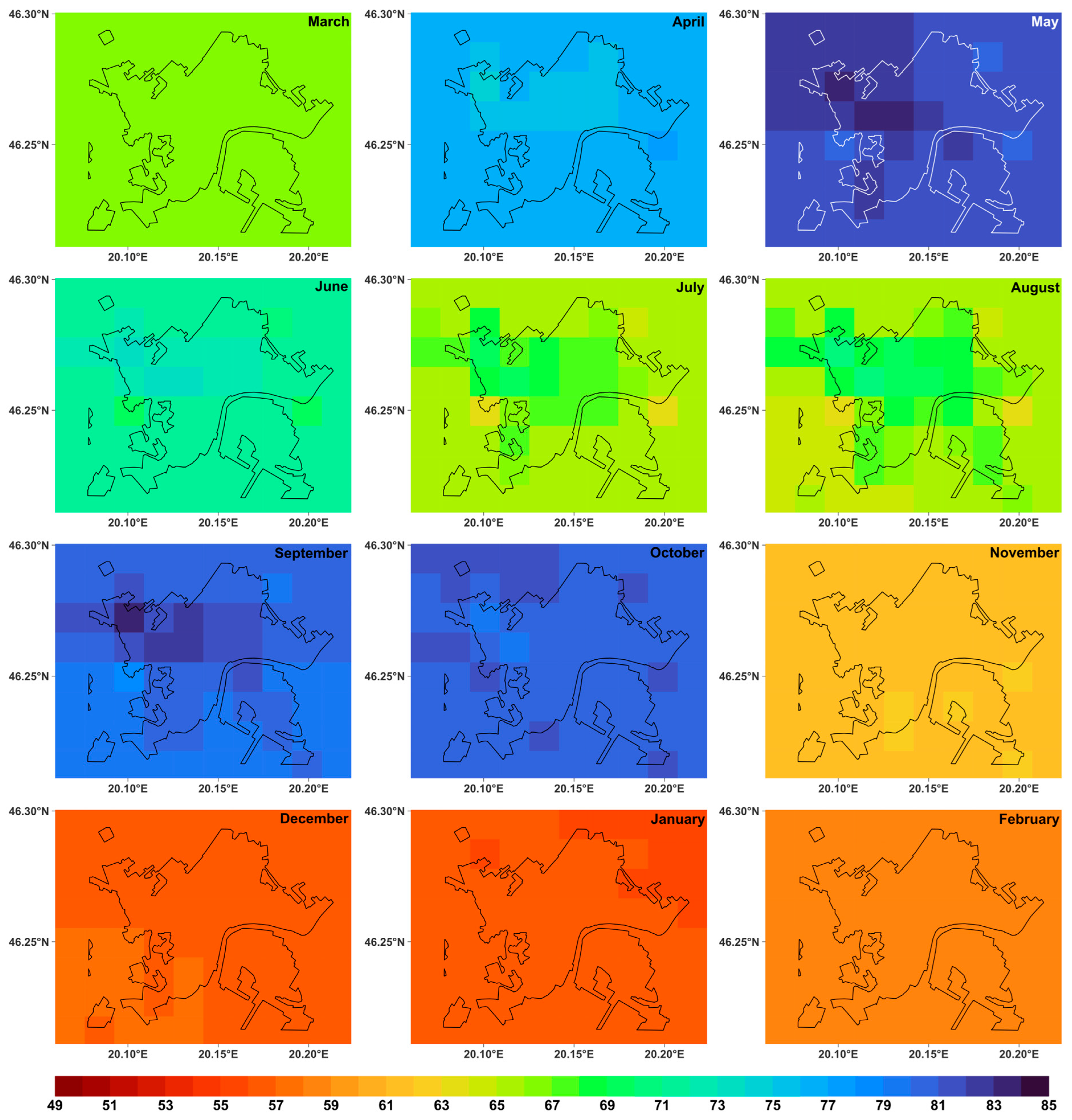

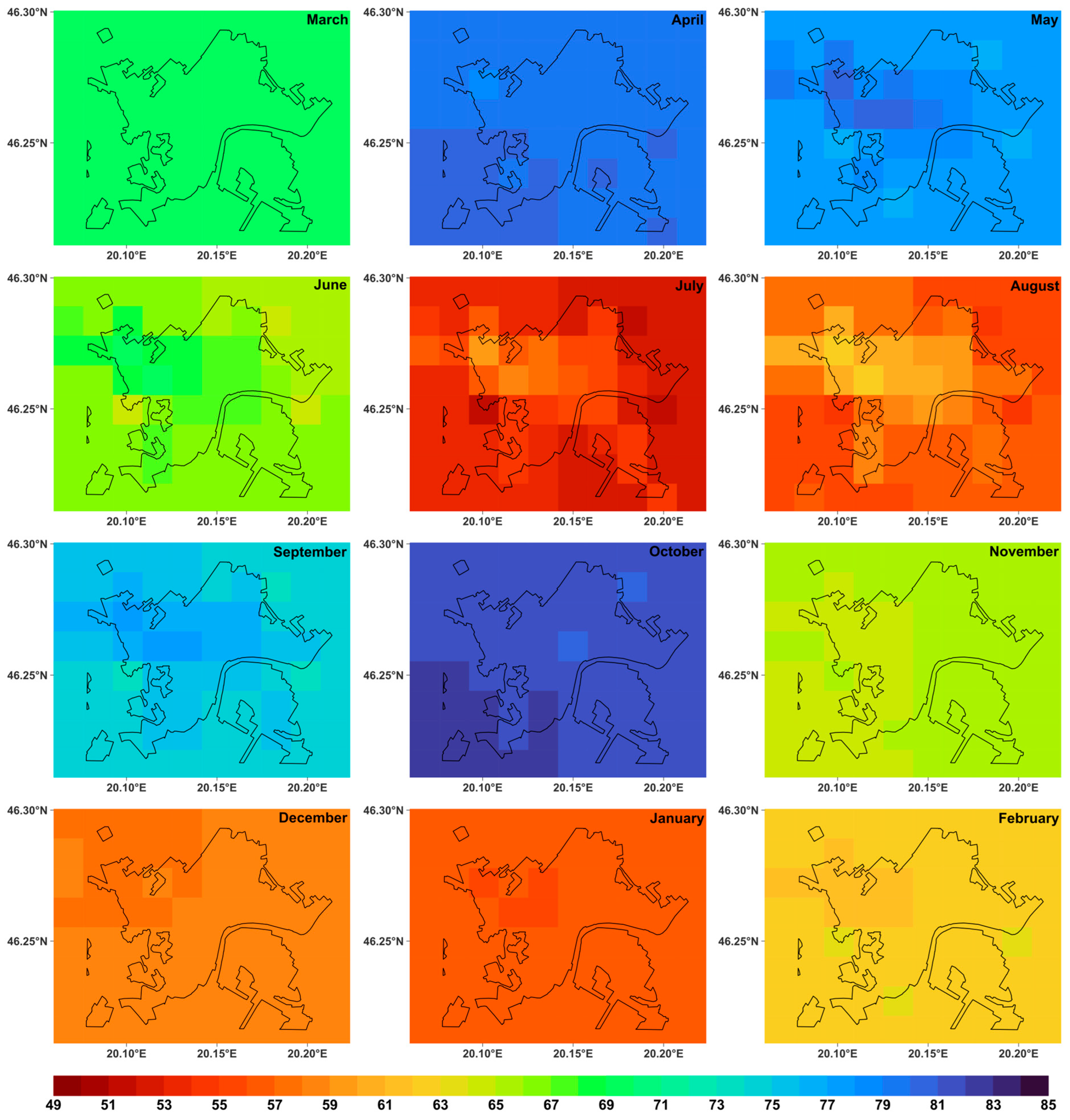


| Database | Emission Scenarios | Resolution | Periods |
|---|---|---|---|
| CarpatClim-HU | – | 10 km | 1971–2000 |
| ALADIN5.2 | RCP4.5, RCP8.5 | 10 km | 1971–2000, 2041–2070, 2071–2100 |
| SURFEX | RCP4.5, RCP8.5 * | 1 km | 1971–2000, 2041–2070, 2071–2100 |
| Land Cover Type | Dense Urban | Temperate Sub-Urban | Industries and Commercial Areas | Road and Rail Networks | Urban Parks |
|---|---|---|---|---|---|
| Fraction of urban and artificial areas | 0.9 | 0.6 | 0.9 | 0.9 | 0.1 |
| Fraction of cultivated and natural areas | 0.1 | 0.4 | 0.1 | 0.1 | 0.9 |
| Building height (m) | 30 | 10 | 20 | 5 | 5 |
Disclaimer/Publisher’s Note: The statements, opinions and data contained in all publications are solely those of the individual author(s) and contributor(s) and not of MDPI and/or the editor(s). MDPI and/or the editor(s) disclaim responsibility for any injury to people or property resulting from any ideas, methods, instructions or products referred to in the content. |
© 2025 by the authors. Licensee MDPI, Basel, Switzerland. This article is an open access article distributed under the terms and conditions of the Creative Commons Attribution (CC BY) license (https://creativecommons.org/licenses/by/4.0/).
Share and Cite
Kovács, A.; Molnár, G. Interplay of Regional Climate Change and Urban Effects: Projected Impacts on Tourism Climate Potential in Szeged, Hungary. Urban Sci. 2025, 9, 447. https://doi.org/10.3390/urbansci9110447
Kovács A, Molnár G. Interplay of Regional Climate Change and Urban Effects: Projected Impacts on Tourism Climate Potential in Szeged, Hungary. Urban Science. 2025; 9(11):447. https://doi.org/10.3390/urbansci9110447
Chicago/Turabian StyleKovács, Attila, and Gergely Molnár. 2025. "Interplay of Regional Climate Change and Urban Effects: Projected Impacts on Tourism Climate Potential in Szeged, Hungary" Urban Science 9, no. 11: 447. https://doi.org/10.3390/urbansci9110447
APA StyleKovács, A., & Molnár, G. (2025). Interplay of Regional Climate Change and Urban Effects: Projected Impacts on Tourism Climate Potential in Szeged, Hungary. Urban Science, 9(11), 447. https://doi.org/10.3390/urbansci9110447







